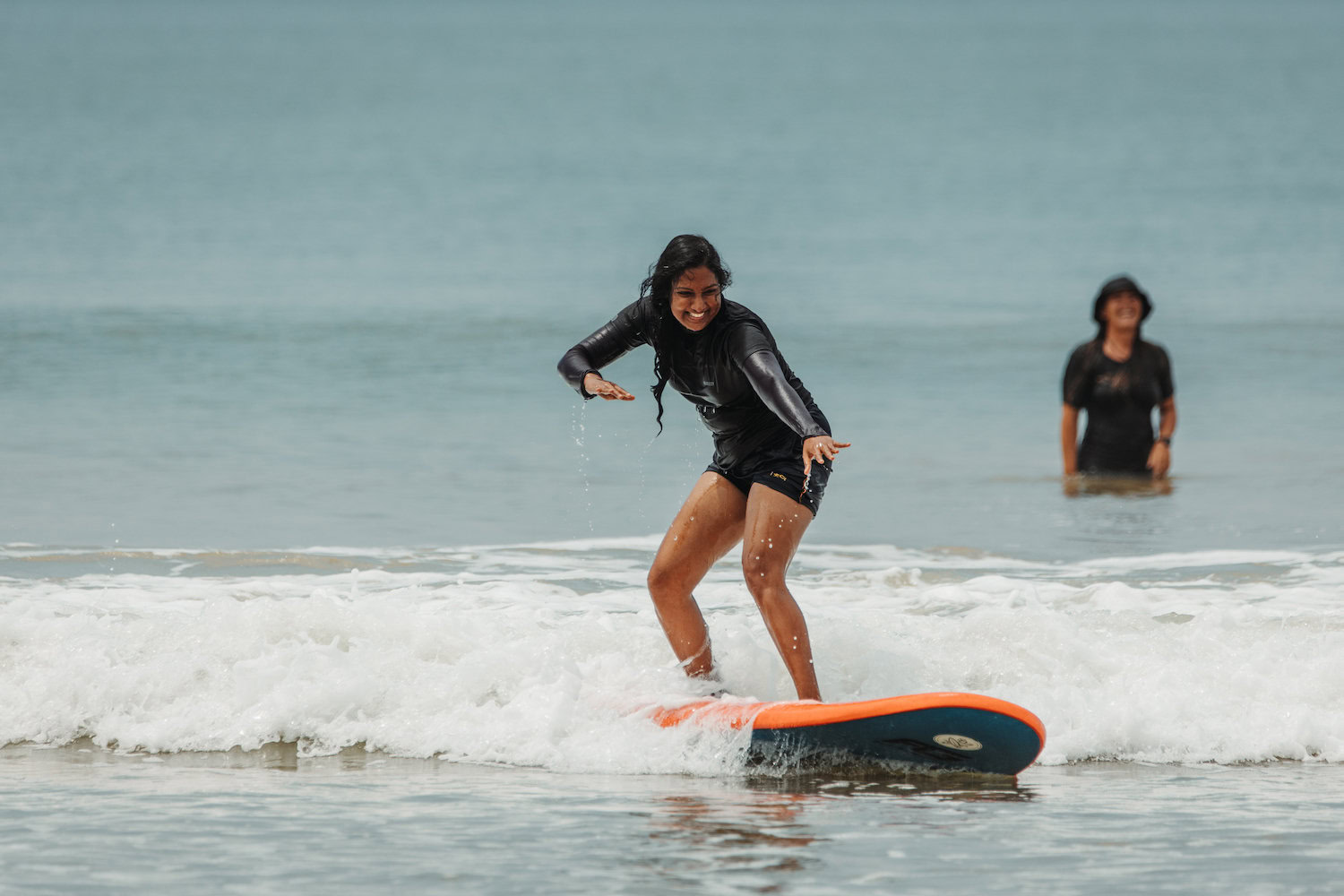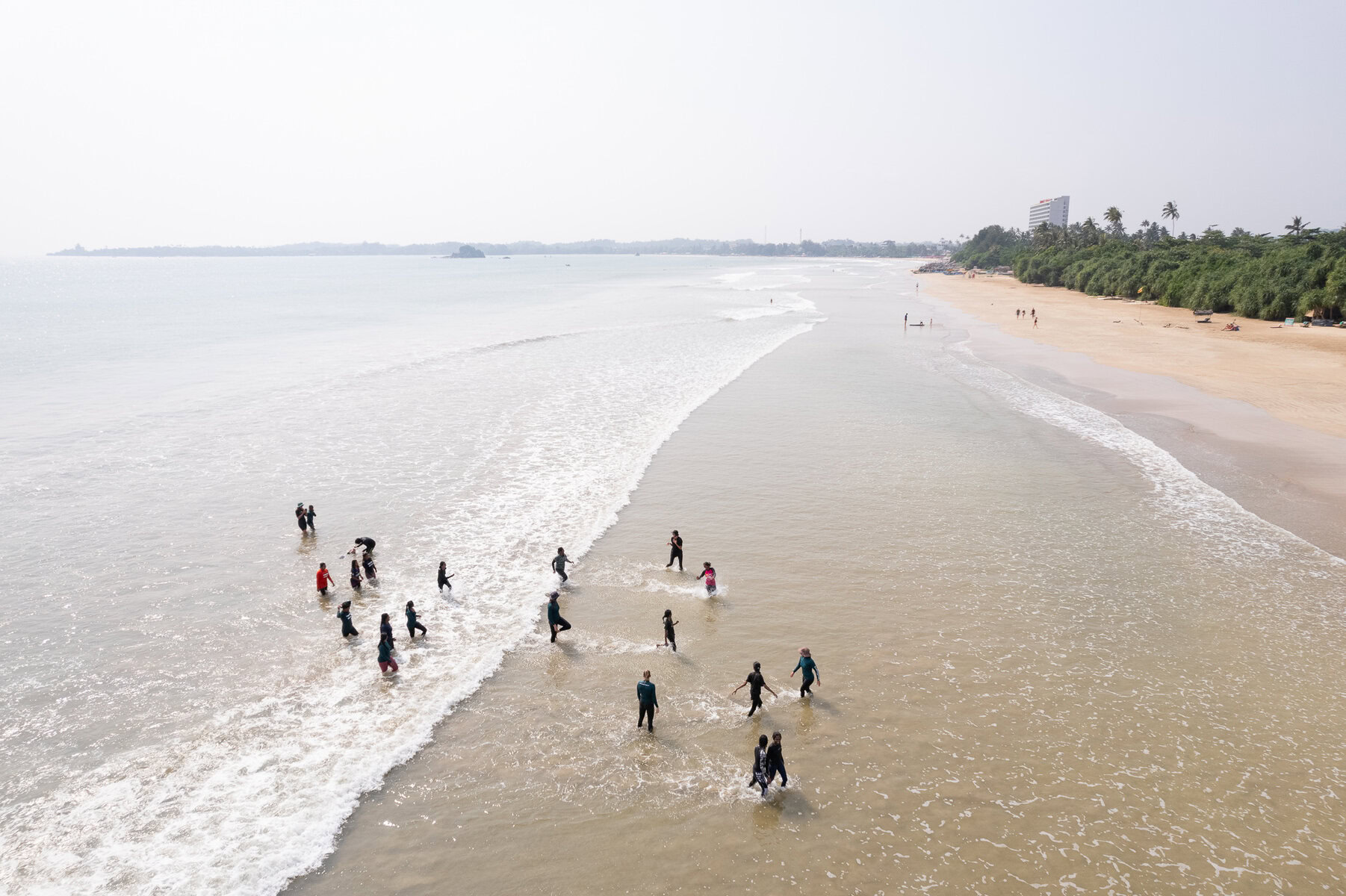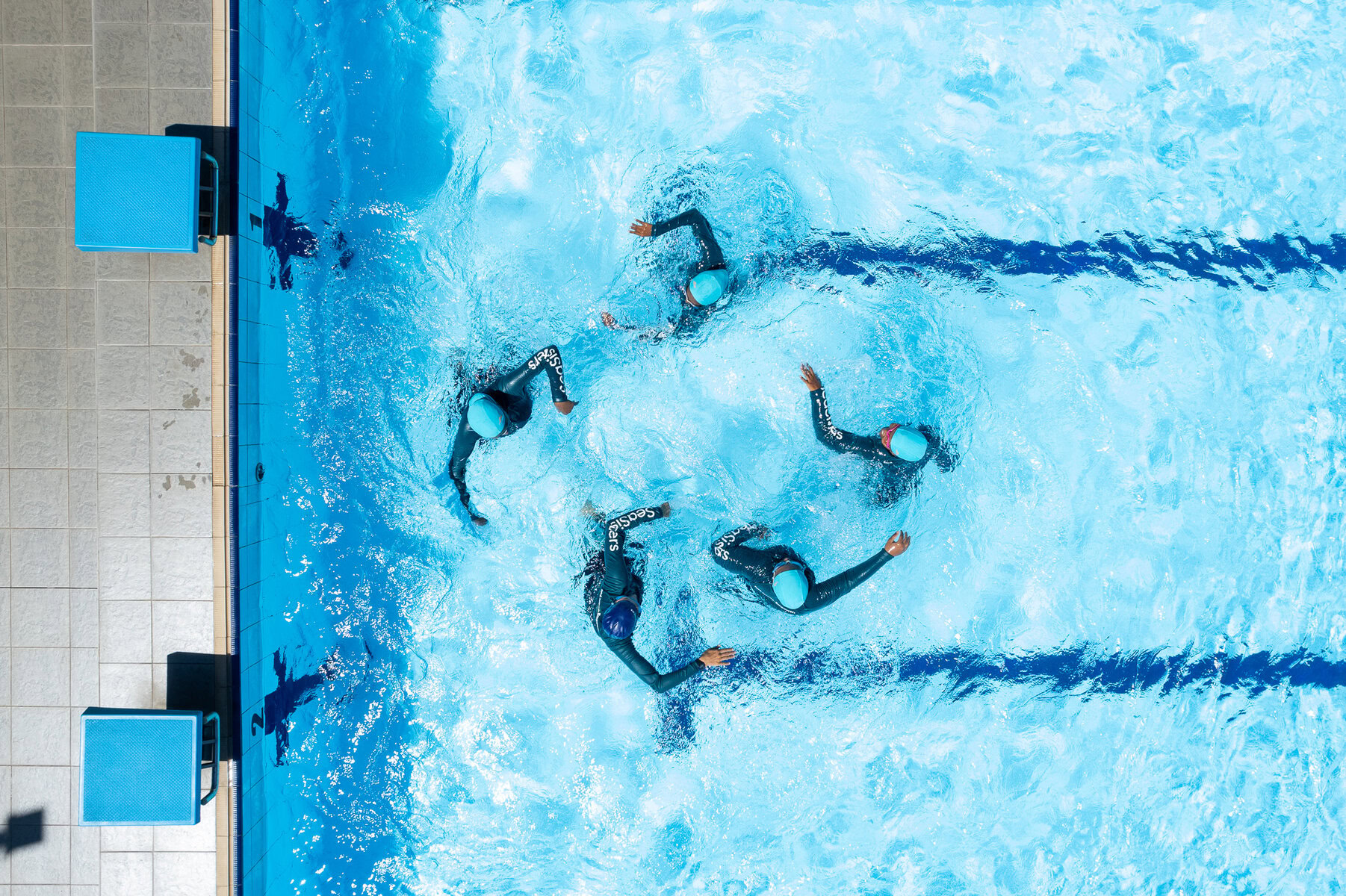When 18-year-old Ishi Mosha — who goes by the nickname Amzhii — glides down the face of a wave, she feels alive. Amzhii just finished school, but she’s already one of the few local female surf instructors in Sri Lanka. “I want to be as free as the ocean,” she says before she paddles out into the sea at daybreak. “When I’m out there, I feel as if there’s no care in the world.”
In December 2023, Amzhii learned to explore the joys of the ocean with SeaSisters, a community of women who conduct free swim and surf sessions for young girls and women in Amzhii’s hometown, Weligama, 148 kilometers south of the Sri Lankan capital Colombo. As a kid, Amzhii watched “Queen of the Waves,” a song from the animated 2010 movie Barbie in a Mermaid Tale during which Barbie effortlessly skims along a curling wave, over and over. “Now I want to film my own ‘Queen of the Waves’ song,” says Amzhii.
Sri Lanka is one of Asia’s leading surf tourism destinations. Yet social norms and fear of the ocean keep many women from accessing the waters. This not only keeps women from enjoying the ocean but also prevents them from benefiting from the socioeconomic rewards it can bring, including through work as swim and surf instructors.
SeaSisters’ co-founder Martina Burtscher recognizes that local women have untapped potential. “Surf tourism is largely male-dominated, with most surf camps and schools run by local men or foreigners,” she says. Burtscher grew up in landlocked Austria and “fell in love with surfing” at 18, but noticed that many women who grew up on the coast across the globe — including in Sri Lanka — were not in the water. “I found it very unfair,” she says. “A woman from a landlocked country like me could enjoy the ocean while others who had the ocean on their doorstep seemed to face barriers.” But “the ocean is for everyone,” she adds.

Burtscher first visited Sri Lanka in July 2017 while working on her master’s thesis, which focused on surfing for women’s empowerment. She met a small collective of local women on Sri Lanka’s east coast, who felt empowered through surfing, but faced sociocultural barriers to participating in the sport. During their conversations, the idea of starting a surf club popped up. So she returned a year later and helped set up Sri Lanka’s first local women-run surf community with American surfer Amanda Prifti. The initiative gained momentum, and local women began reaching out to them on Instagram to ask for surf lessons.
So Burtscher and Prifti moved to the country’s south coast and began SeaSisters in October 2018 with just six young students to support more Sri Lankan women’s access to the ocean. Over the next six years, SeaSisters trained 150 women and girls to surf and swim while navigating the Covid-19 pandemic and the country’s worst-ever economic crisis.
Weighed down by negative news?
Our smart, bright, weekly newsletter is the uplift you’ve been looking for.
According to the Global Gender Gap Report 2024, Sri Lankan women have fair and equal access to work in both professional and technical fields, but other studies have found that they are still largely underrepresented in decision-making spaces and sports. Although women have access to free education and universal health services, deep-rooted social norms restrict women from public and recreational spaces. What this means is that in rural areas, women and girls are often expected to submit to traditional gender norms: stay at home, cook, care for their families, speak little in public and limit their interaction with boys. These norms are so internalized that how a woman behaves in public is critical to her family’s reputation.
Meanwhile, people in Sri Lanka often view surfing as a culture linked to beach parties, drugs, sex and alcohol abuse. Parents worry that if their daughters start surfing, they will be pulled into that lifestyle and harm their reputation.

So Burtscher realized that it’s crucial to foster an environment that respects some of these cultural norms, such as wearing modest clothing — like leggings and t-shirts instead of bikinis — and welcoming parents to watch lessons. As a result, “parents quickly noticed that learning to swim and surf was beneficial for the girls, helping them gain new skills and feel happier,” Burtscher says.
Dee Gibson, British-Sri Lankan designer, hotelier and founder of the platform HERA Project X that spotlights creative female entrepreneurs, says that it often takes a “sensitive approach in community-driven projects to build momentum and courage for change.” And once the “cultural barriers are lifted, there’s no stopping [local women].”
“It also helps to create a cultural shift where young women come together to support one another,” says Irish surfer and social ecologist Easkey Britton. Indeed, this is one of the main aims of Amzhii, who now volunteers at SeaSisters teaching other girls to surf.

SeaSisters also faced other challenges. When they looked for a swimming pool to practice in, people were skeptical and told them that Sri Lankan women could drown. In fact, drowning is a major cause of death in Sri Lanka. Across the globe, two in three women cannot swim. Although Sri Lanka is surrounded by a 1,340-kilometer coastline, many locals view the ocean as dangerous, and these fears were exacerbated by the 2004 Indian Ocean tsunami that claimed over 31,000 lives on the island. One study found that most of the women and young girls who drowned in the tsunami couldn’t swim.
Kalpa Gandhari, SeaSisters’ director of program and community, was just 10 years old when the tsunami took away the homes and lives of many in her village, Unawatuna. Gandhari and her family ran from their house to survive, so when she joined SeaSisters as a translator, one of her goals was to learn to swim. “My mother was skeptical and wanted to know where I was going. Eventually, she also joined SeaSisters in her 50s and started to learn swimming,” she says.
Since many women are anxious about swimming in large bodies of water, training starts slowly at SeaSisters, with basics like blowing bubbles that help control breath. Currently, the group’s qualified instructors and volunteers host swim and surf lessons on Saturdays and more advanced training sessions — designed for those who want to pursue it as a career — on Sundays.
On International Women’s Day, sisters Himaya and Udani Hewamadduma — both recently qualified as international swimming teachers — are busy at work. Dressed in a light blue shirt with long sleeves and black leggings, Himaya encourages a group of junior school girls to swim in Weligama. The girls giggle as Udani, sitting by the pool, shares tips.

Udani grew up close to the ocean, and “always loved it,” she says, but when she wanted to learn swimming, she couldn’t find a female instructor. The few places that offered classes were expensive. “So I wanted to be a swim instructor and help young girls to swim,” says Udani, who’s also the program and community manager at SeaSisters and studies marine science at the Ocean University in Sri Lanka.
As a woman, when Udani conducts lessons, people still look at her “in a way they don’t look at men.” She notes that “people find it a bit strange as it’s still a new thing” to see a local woman surf or swim. She’s hopeful that this will change in the future. Many of the other women studying marine science at her university are also trained swim instructors, she notes. But “they need opportunities in the industry to work as trainers.”
Britton adds that programs like SeaSisters often have Western instructors and depend on foreign aid. So a key challenge is overcoming “white saviorism,” and developing initiatives that self sustain and “provide socio-economic support and empower local participants to take on leadership roles.” Britton sees this happening within SeaSisters: “Some of the first women who participated in the program are now mentoring the next generation of female surfers in Sri Lanka.”
For now, the numbers may seem small, but for young women like Udani and Amzhii, the freedom to connect with the ocean, challenge social norms and become changemakers in their society has been transformative. Just a few years ago, “it wasn’t even considered an option,” SeaSisters’ director Gandhari says. Although it’s a “long journey,” she adds that cultural perceptions are “slowly changing now as more and more women get into the water.”
As Udani gathers a group of girls by the ocean for their first time on a surfboard, a few others watch intently from the shore. “I want to be like Udani akka (sister) when I grow up,” one of them says, smiling.
The post In Sri Lanka, ‘the Ocean Is For Everyone’ appeared first on Reasons to be Cheerful.




